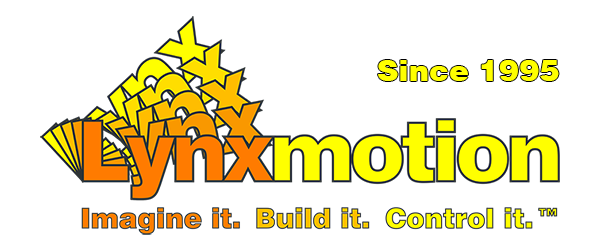Changes for page LSS Configuration Software
Last modified by Eric Nantel on 2024/07/12 11:23
Change comment: Uploaded new attachment "lss-config-temp.jpg", version {1}
Summary
-
Page properties (2 modified, 0 added, 0 removed)
-
Attachments (0 modified, 3 added, 1 removed)
Details
- Page properties
-
- Author
-
... ... @@ -1,1 +1,1 @@ 1 -xwiki:XWiki. RB11 +xwiki:XWiki.CBenson - Content
-
... ... @@ -1,6 +1,6 @@ 1 -[[image: lss-config-full-window-0001.png||width="520"]]1 +[[image:LSS-Config-BETA.png||queryString="width=350" width="350"]] 2 2 3 -** TableofContents**3 +**Page Contents** 4 4 5 5 {{toc/}} 6 6 ... ... @@ -19,7 +19,7 @@ 19 19 * COM port selection 20 20 * Connect (toggle ON / OFF) 21 21 22 -Connection to the servo is done automatically, via any properly installed USB to serial interface like the [[LSS Adapter board>>doc:servo-erector-set-system.ses-electronics.ses-modules.lss-adapter-board.WebHome]]. Once the servo is powered and properly connected to the computer, the COM port should appear in the COM port list. Ensure the board is recognized by the computer and if not, install the proper drivers. If you have multiple communication ports active, go to Windows -> Device Manager to determine which is appropriate for the USB to serial adapter you are using. Click CONNECT to connect to the servo. The software automatically scans all standard baud rates using ID254 (broadcast ID) and waits for a reply from the servo connected. Should an incorrect COM port be selected, the software will keep trying to connect. If youwish to change the COM port selected youmust disconnect, select the correct COM port and reconnect. If you are not sure which COM port to select, in Windows, go to Device Manager -> Ports (COM & LPT) and select the port associated with the USB to serial device.22 +Connection to the servo is done automatically, via any properly installed USB to serial interface like the [[LSS Adapter board>>doc:servo-erector-set-system.ses-electronics.ses-modules.lss-adapter-board.WebHome]]. Once the servo is powered and properly connected to the computer, the COM port should appear in the COM port list. Ensure the board is recognized by the computer and if not, install the proper drivers. If you have multiple communication ports active, go to Windows -> Device Manager to determine which is appropriate for the USB to serial adapter you are using. Click CONNECT to connect to the servo. The software automatically scans all standard baud rates using ID254 (broadcast ID) and waits for a reply from the servo connected. Should an incorrect COM port be selected, the software will keep trying to connect. You must disconnect, select the correct COM port and reconnect. If you are not sure which COM port to select, in Windows, go to Device Manager -> Ports (COM & LPT) and select the port associated with the USB to serial device. 23 23 24 24 == Firmware Update == 25 25 ... ... @@ -37,12 +37,12 @@ 37 37 38 38 = Servo Control = 39 39 40 - {{lightbox image="lss-config-control.jpg" width="350"/}}40 +[[image:lss-config-control.jpg]] 41 41 42 42 The servo control section allows you to visually move the servo and change a variety of parameters, including: 43 43 44 44 * Position: blue caret 45 -* OriginOffset: magenta caret45 +* First Position: magenta caret 46 46 * RPM: green arrow 47 47 48 48 At the lower left, the servo model is shown, as well as the LED color. ... ... @@ -49,7 +49,7 @@ 49 49 50 50 == Configurations == 51 51 52 - {{lightbox image="lss-config-configurations.jpg" width="350"/}}52 +[[image:lss-config-configurations.jpg]] 53 53 54 54 Upon connection, the software will read all configuration values and update the values in the "configurations" section. Visit the [[LSS Communication Protocol>>doc:lynxmotion-smart-servo.lss-communication-protocol.WebHome]] page for more information about commands, actions and configurations. 55 55 ... ... @@ -65,7 +65,7 @@ 65 65 66 66 The sensor graphing feature of the software allows you to select, display and record, with respect to time, the output from all of the servo's sensors. 67 67 68 - {{lightbox image="lss-config-graph.jpg" width="700"/}}68 +[[image:lss-config-graph.jpg]] 69 69 70 70 x-Axis: seconds 71 71 ... ... @@ -94,8 +94,10 @@ 94 94 [[image:lss-config-300s.jpg]] [[image:lss-config-infs.jpg]] 95 95 )))|(% style="width:777px" %)Time Window (30s / 60s / 300s / Total) 96 96 97 -= Command Line {{lightboximage="lss-config-command-line.jpg" width="700"/}} =97 += Command Line = 98 98 99 +[[image:lss-config-command-line.jpg||alt="LSS Config Command Line"]] 100 + 99 99 The custom command line interface both allows you to communicate directly with an individual servo, send commands to it (and view replies), as well as get responses to queries from the software. Within the command interface, you might see the following: 100 100 101 101 |(% style="width:114px" %)**>>**|(% style="width:1364px" %)Command sent to the servo
- lss-config-full-window-0001.png
-
- Author
-
... ... @@ -1,1 +1,0 @@ 1 -xwiki:XWiki.RB1 - Size
-
... ... @@ -1,1 +1,0 @@ 1 -230.3 KB - Content
- LSS-Config-BETA.png
-
- Author
-
... ... @@ -1,0 +1,1 @@ 1 +xwiki:XWiki.ENantel - Size
-
... ... @@ -1,0 +1,1 @@ 1 +292.7 KB - Content
- lss-config-connect-firmware.jpg
-
- Author
-
... ... @@ -1,0 +1,1 @@ 1 +xwiki:XWiki.RB1 - Size
-
... ... @@ -1,0 +1,1 @@ 1 +10.4 KB - Content
- lss-config-temp.jpg
-
- Author
-
... ... @@ -1,0 +1,1 @@ 1 +xwiki:XWiki.CBenson - Size
-
... ... @@ -1,0 +1,1 @@ 1 +327.3 KB - Content

